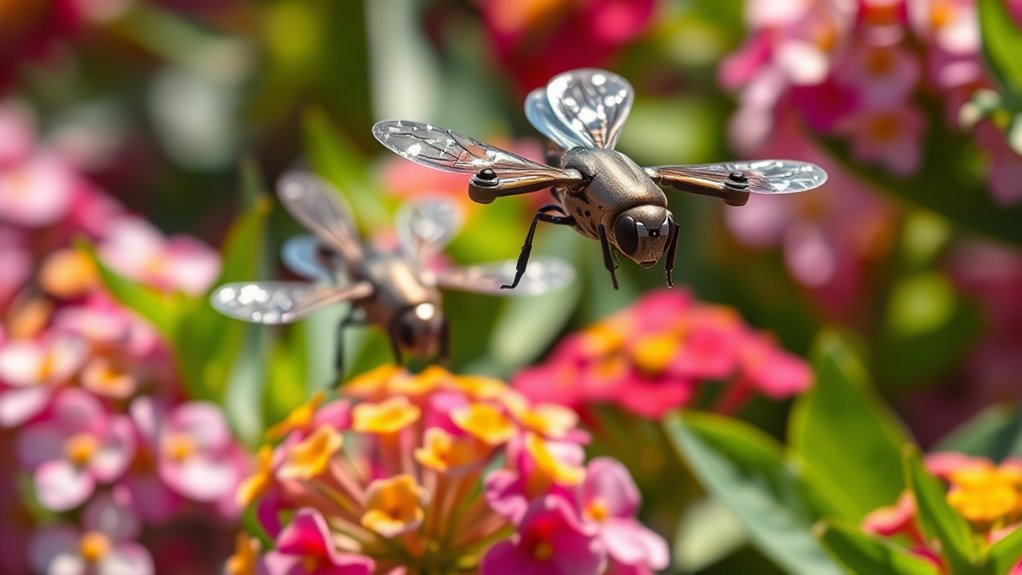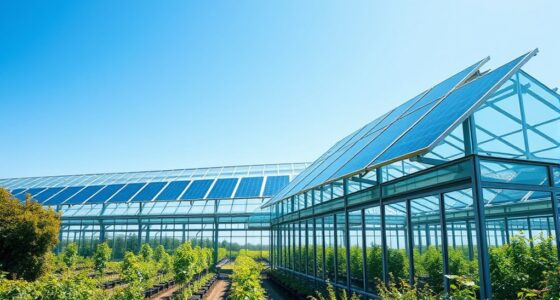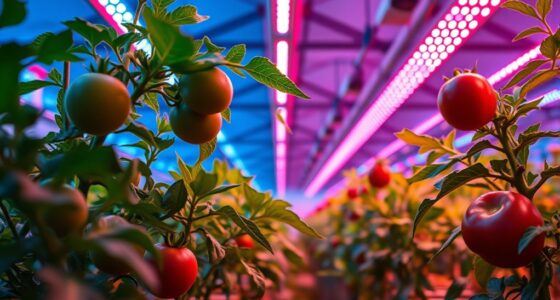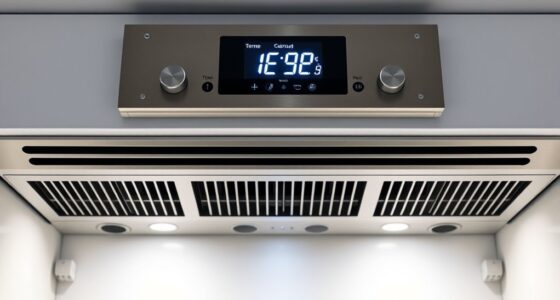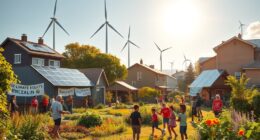Drone pollinators are tiny robots designed to supplement or replace natural bees, ensuring your crops get the pollination they need for healthy fruit and seed production. They navigate precisely, identify flowering stages, and adapt to environmental changes to maximize efficiency. Unlike natural pollinators, these drones work tirelessly, even in tough conditions, helping to secure your food supply. Curious to discover how these innovative bots are transforming agriculture? Keep exploring to find out more.
Key Takeaways
- Drone pollinators are autonomous robots designed to supplement or replace declining natural pollinators like bees.
- They mimic insect pollination actions, ensuring precise pollen transfer and maximizing crop yields.
- Equipped with advanced sensors, they assess flower health and environmental conditions in real-time.
- These tiny bots operate efficiently in large farms and difficult terrains, overcoming weather and pesticide challenges.
- They support sustainable agriculture by maintaining crop production despite natural pollinator declines.

Have you ever wondered if drones could play a role in pollination? It might sound like science fiction, but in the world of robotic agriculture, it’s quickly becoming a reality. Farmers face a growing challenge: declining bee populations and the unpredictable weather that hampers traditional pollination methods. Enter drone pollinators—tiny, purpose-built robots designed to supplement or even replace natural pollinators when needed. These machines are equipped with advanced pollination technology, allowing them to mimic the actions of bees and other insects, ensuring that crops receive the necessary pollination to produce fruit and seeds.
In robotic agriculture, drones are becoming essential tools for efficiency and reliability. Unlike natural pollinators, they don’t suffer from fatigue, weather constraints, or pesticide exposure. With precise navigation systems and sensors, they can target specific plants or flowers, delivering pollen with accuracy that rivals or surpasses that of bees. This targeted approach reduces waste and maximizes pollination success, especially in large-scale farms where manual labor or natural pollination alone might fall short. As the technology progresses, these drones can be programmed to operate autonomously, working tirelessly during ideal conditions to ensure crops are pollinated thoroughly and on schedule.
Pollination technology embedded in these robots involves more than just mechanical pollen transfer. Researchers are developing systems where drones can identify flowering stages, assess flower health, and adapt their pollination strategies in real-time. This intelligent operation means that drones don’t just randomly distribute pollen; they optimize their activity based on environmental cues and crop needs. Such innovations help maintain high yields and quality, even when natural pollinators are scarce or absent. Additionally, this technology can be deployed in difficult terrains or in protected environments where traditional pollinators might not reach, broadening the scope of crop production possibilities. Furthermore, integrating QA best practices into the development and deployment of these drone systems ensures their reliability and effectiveness in supporting sustainable agriculture.
Frequently Asked Questions
How Do Drone Pollinators Compare to Natural Bees in Efficiency?
When comparing drone pollinators to natural bees, you’ll find that drone bots can be quite efficient in pollination. They’re designed for consistent pollination efficiency, often surpassing bees in controlled environments. Bee comparison shows natural bees excel in adaptability and natural behavior, but drones provide a reliable, targeted alternative, especially where bee populations decline. Overall, drone pollinators complement bees, potentially enhancing pollination success and crop yields.
Are Drone Pollinators Environmentally Safe and Biodegradable?
You might wonder if drone pollinators are environmentally safe and biodegradable. While they’re designed to reduce biodegradability concerns, their environmental impact depends on materials used and disposal methods. Most drone components aren’t biodegradable, raising potential concerns about pollution. However, ongoing innovations aim to create eco-friendly, biodegradable parts, minimizing environmental impact. Overall, you should consider both their benefits and the need for sustainable materials to guarantee minimal ecological footprint.
What Is the Cost of Deploying Drone Pollinators at Scale?
You wonder about the cost of deploying drone pollinators at scale. The economic feasibility depends on technology costs, maintenance, and deployment size. Scalability challenges include ensuring drones can cover large areas efficiently and operate reliably in diverse conditions. While initial investments may be high, ongoing advancements could lower costs, making widespread use more practical. Ultimately, balancing these factors will determine if drone pollinators are a sustainable solution for future agriculture.
How Long Do Drone Pollinators Typically Operate Before Needing Maintenance?
Bumping against battery life boundaries, drone pollinators typically operate for about 20 to 30 minutes before needing a recharge or maintenance. You should follow a regular maintenance schedule to keep them humming smoothly, checking batteries, blades, and sensors. This routine guarantees they stay reliable, reducing downtime and maximizing their pollination potential. With proper upkeep, these tiny bots can work efficiently, supporting your crops from dawn to dusk.
Can Drone Pollinators Adapt to Different Crop Types and Climates?
You’ll find that drone pollinators are designed to adapt to different crop types and climates, enhancing crop diversity and climate resilience. They can be programmed to recognize various plants and adjust their pollination techniques accordingly. This flexibility allows you to use them across diverse environments, ensuring effective pollination even in changing climate conditions. As a result, drone pollinators help you maintain healthy, resilient crops year-round.
Conclusion
You might worry that drone pollinators can’t match the effectiveness of natural bees, but they’re designed to complement our ecosystems, not replace them. These tiny bots can operate in harsh conditions and reach areas bees can’t access, boosting crop yields where traditional pollination struggles. Embracing this technology doesn’t mean neglecting nature; it’s about enhancing it, ensuring food security in a changing world. With careful integration, drone pollinators could become crucial allies in sustainable agriculture.
